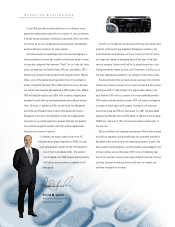Audiovox 2000 Annual Report Download - page 20
Download and view the complete annual report
Please find page 20 of the 2000 Audiovox annual report below. You can navigate through the pages in the report by either clicking on the pages listed below, or by using the keyword search tool below to find specific information within the annual report.
In February 2000, the Company completed a follow on offering of
3,565,000 Class A common shares at a price to the public of $45.00 per
share. Of the 3,565,000 shares sold, the Company offered 2,300,000
shares and 1,265,000 shares were offered by selling shareholders.
Audiovox received approximately $96,573 after deducting expenses. The
Company used these net proceeds to repay a portion of amounts out-
standing under their revolving credit facility, any portion of which can be
reborrowed at any time. The Company did not receive any of the net pro-
ceeds from the sale of shares by the selling shareholders.
The Company believes that it has sufficient liquidity to satisfy its antici-
pated working capital and capital expenditure needs through November 30,
2001 and for the reasonable foreseeable future.
Impact of Inflation and Currency Fluctuation
Inflation has not had a significant impact on the Company’s financial posi-
tion or operating results. To the extent that the Company expands its
operations into Latin America and the Pacific Rim, the effects of inflation
and currency fluctuations in those areas could have growing significance
to its financial condition and results of operations. Fluctuations in the for-
eign exchange rates in Pacific Rim countries have not had a material
adverse effect on the Company’s consolidated financial position, results
of operations or liquidity.
While the prices that the Company pays for the products purchased from
its suppliers are principally denominated in United States dollars, price
negotiations depend in part on the relationship between the foreign cur-
rency of the foreign manufacturers and the United States dollar. This rela-
tionship is dependent upon, among other things, market, trade and
political factors.
Seasonality
The Company typically experiences some seasonality in its operations.
The Company generally experiences a substantial amount of its sales dur-
ing September, October and November. December is also a key month for
the Company due to increased demand for its products during the holiday
season. This increase results from increased promotional and advertising
activities from the Company’s customers to end-users.
Recent Accounting Pronouncements
In June 1999 and June 2000, respectively, the Financial Accounting
Standards Board (FASB) issued Statement of Financial Accounting
Standards (SFAS) No. 137, “Accounting for Derivative Instruments and
Hedging Activities-Deferral of the “Effective Date of FASB Statement
No. 133” and SFAS No. 138, “Accounting for Certain Derivative Instruments
and Certain Hedging Activities”. SFAS 137 and 138 amend SFAS 133,
“Accounting for Derivative Instruments and Hedging Activities,” which was
issued in June 1998. SFAS 137 deferred the effective date of SFAS 133 to
all fiscal quarters of fiscal years beginning after June 15, 2000. SFAS 133
establishes accounting and reporting standards for derivative instruments,
including certain derivative instruments embedded in other contracts and
for hedging activities. It requires that an entity recognize all derivatives as
either assets or liabilities in the statement of financial position and meas-
ures those instruments at fair value. Management of the Company does not
believe that the implementation of SFAS 133 will have a material impact on
its financial position, results of operations or liquidity.
On December 3, 1999, the Securities and Exchange Commission (SEC)
issued Staff Accounting Bulletin No. 101—“Revenue Recognition in
Financial Statements” (SAB No. 101). SAB No. 101 provides the SEC
staff’s views in applying generally accepted accounting principles to rev-
enue recognition in the financial statements. SAB No. 101B delayed the
implementation date for registrants to adopt the accounting guidance
contained in SAB No. 101 by no later than the fourth fiscal quarter of the
fiscal year beginning after December 15, 1999. Management of the
Company does not believe that applying the accounting guidance of SAB
No. 101 will have a material effect on its financial position, results of
operations or liquidity.
In September 2000, the Emerging Issues Task Force (EITF) issued EITF 00–22,
“Accounting for Points and Certain Other Time-Based or Volume-Based
Sales Incentive Offers, and Offers for Free Products or Services to Be
Delivered in the Future”. EITF 00-22 addresses, among other issues, how
a vendor should account for an offer to a customer to rebate or refund a
specified amount of cash that is redeemable only if a customer completes
a specified cumulative level of revenue transactions or remains a cus-
tomer for a specified time period. At the January 2001 meeting, the Task
Force affirmed its conclusions reached at the November 2000 meeting, at
which time they concluded that a vendor should recognize a cash rebate
or refund obligation as a reduction of revenue based upon a systematic
and rational allocation of the cost of honoring rebates or refunds earned
and claimed to each of the underlying revenue transactions. The consen-
sus is effective for interim or annual periods ending after February 15,
2001. A portion of the Company’s sales programs are in the form of vol-
ume incentive rebates which, as of November 30, 2000, have been
recorded in selling expenses on the accompanying consolidated state-
ments of income. Implementation of EITF 00-22 for the Company will be in
the first fiscal quarter of 2001. Management of the Company is in the
process of assessing the impact that implementation will have on the
consolidated financial statements.
MANAGEMENT’SDISCUSSION AND ANALYSIS OF
FINANCIAL CONDITION AND RESULTS OF OPERATIONS (continued)
18
























